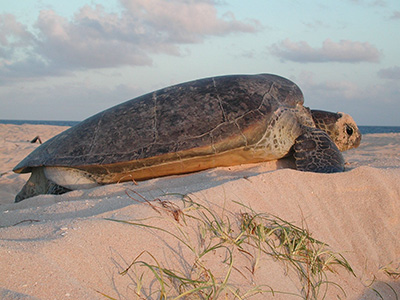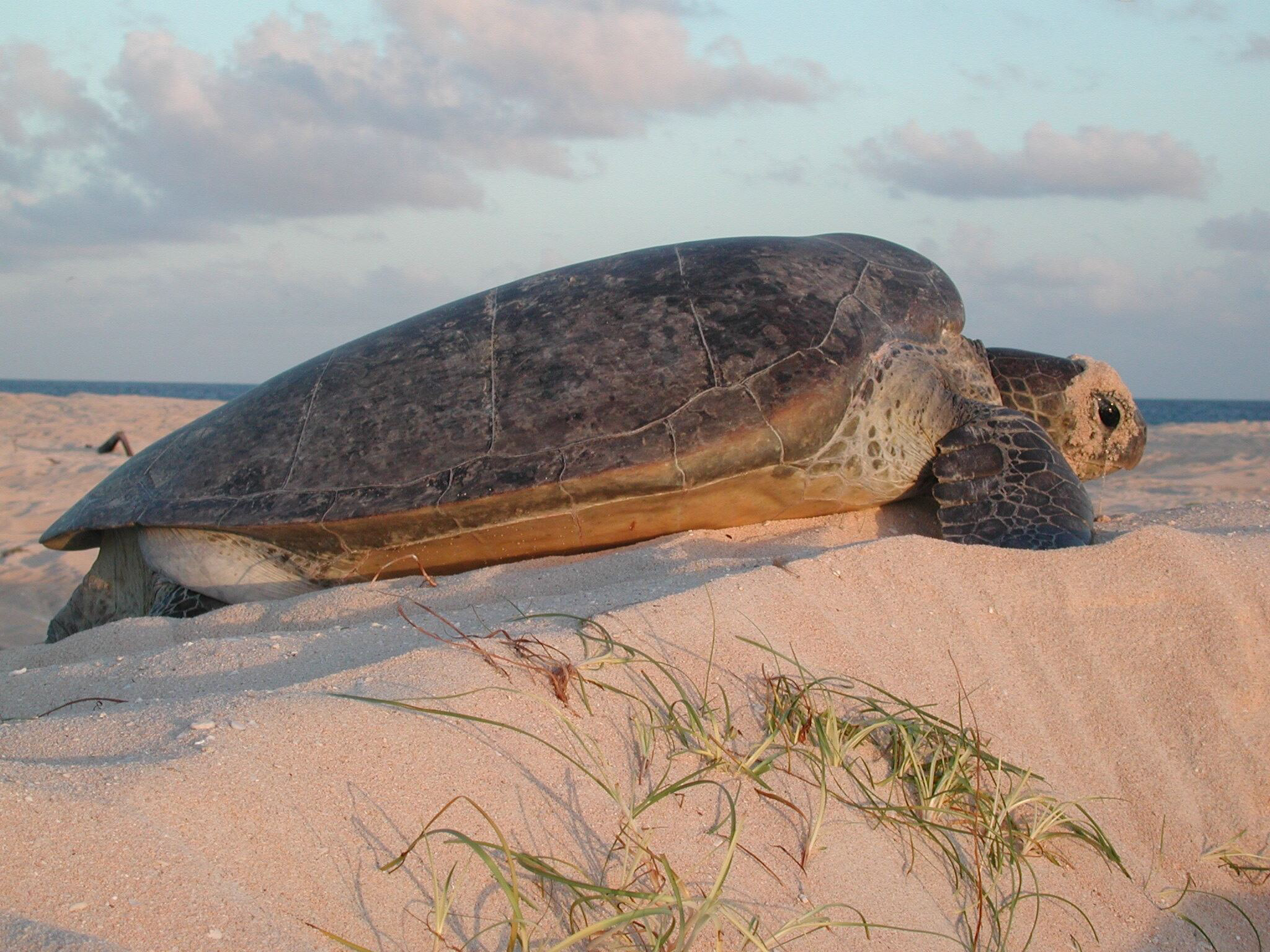Green turtles
Safeguarding the green turtle in Queensland waters
Green turtles have inhabited the seas for millions of years, but few large nesting populations remain. Three are in Queensland and need our support to survive.
Fast facts
Common name: Green turtle
Scientific name: Chelonia mydas
Family: Cheloniidae (hard-shelled sea turtles)
Status: Endangered
Habitat: Coastal waters, seagrass pastures, oceans and coral reefs rich in seaweeds in tropical and subtropical areas
Species overview
The green turtle is known for its smooth, heart-shaped shell and paddle-like flippers. It gets its name from the greenish colour of its body fat. While green turtles have inhabited the world’s oceans for hundreds of millions of years, few large nesting populations remain, and there are concerns about their survival.
Green turtles hold profound cultural, spiritual and economic significance for First Nations people and many coastal communities.
These turtles spend their whole life at sea, except when laying eggs. Nesting females return to where they hatched to lay their eggs.
Three distinct genetic stocks of green turtles breed in Queensland:
- southern Great Barrier Reef (southern GBR)
- northern Great Barrier Reef (northern GBR)
- Gulf of Carpentaria.
The fourth distinct genetic stock found here is Coral Sea green turtles, which live in Queensland waters but do not breed here.
In northern Queensland, Raine Island is the world’s largest green turtle rookery, with an annual nesting population of tens of thousands of females. Unfortunately, climate change, particularly rising sea levels and temperatures, impacts the turtle’s breeding success, which has declined since 1996.
In the southern Great Barrier Reef, a genetically distinct group nests in the Capricorn/Bunker group of islands, with increasing nesting abundance.
Ecology and behaviour
Green turtles are an integral part of our coastal ecosystems. Turtle grazing helps to maintain the seagrass communities, which are healthy nurseries for invertebrates and fish. The turtles also recycle nutrients, making them available to other animals and plants, and spread seagrass seeds to re-establish seagrass communities.
Green turtles grow slowly, taking 30–50 years to reach maturity, after which females will nest every 3–7 years. Over a nesting season, females may lay up to 6 times.
In eastern Queensland, nesting occurs between late November and January. They are all year-round nesters in the Gulf of Carpentaria.
Green turtles that nest here migrate from numerous feeding grounds dispersed through Indonesia, Papua New Guinea, Solomon Islands, Vanuatu, Fiji and New Caledonia and from Queensland, Northern Territory and Western Australia. They make long migrations between feeding grounds and nesting beaches. Some of the longest known migrations made by turtles that nest in the southern Great Barrier Reef exceed 2,600km, but the average is about 400km. The longest migration recorded is more than 6,000km, from Howick Reefs in the northern Great Barrier Reef to French Polynesia, where the turtle laid 3 clutches of eggs.
Nesting females choose a site high on the beach, dig a hole with their flippers, and lay about 115 eggs per clutch before covering them with sand.
The eggs are round, roughly the size of ping-pong balls. They require temperatures between 25–33°C during their incubation of around 60 days. As with other marine turtles, the nest temperature determines the sex of the hatchlings. Males result from cooler temperatures and females from warmer ones.
Green turtle hatchlings are shiny black above and white below, with white margins around their shell and flippers. Their average shell length is 5cm, and each hatchling weighs approximately 25g. It’s estimated that as few as 1 in 1,000 hatchlings survive to adulthood. The hatchlings play an important role as a prey species in the food chain.
Although juvenile green turtles are carnivorous, the adults are herbivores, feeding on algae, seaweeds, seagrass (Halophila ovata) and mangrove fruits.

Characteristics
Green turtles have:
- olive-green colour above, usually mottled with brown, reddish-brown and black
- whitish or cream colour below
- smooth, high domed carapace (shell) that can grow to more than 1m, with non-overlapping scutes (scales)
- paddle-like flippers
- an average adult weight of 150kg.
Threats
- Climate change, particularly rising sea levels and temperatures
- Commercial and recreational fishing and crabbing
- Propeller strikes from boats
- Unsustainable hunting practices
- Introduced predators, including foxes, pigs and dogs
- Marine pollution and debris
- Habitat modification.
What’s being done?
- In 1950, the Queensland Government stopped the commercial harvesting of green turtles in southern Queensland in response to concerns over the depleted turtle population. Approximately one turtle generation later, we recorded a three-fold increase in the southern Great Barrier Reef green turtle population (indicated by nesting numbers on Heron Island).
- We developed the Queensland Marine Turtle Conservation Strategy 2021–2031, which identifies threats to the species and advises research and monitoring of the 10 genetic stocks for the six species of marine turtles found in Queensland, including the green turtle.
- We manage our national parks and marine protected areas—including the Great Barrier Reef Coastal Marine Park, Great Sandy Marine Park, and Moreton Bay Marine Park—to protect important turtle ecosystems and regulate potentially harmful activities to minimise impacts on turtle populations and habitats.
- The Raine Island Recovery Project has tried to restore and protect nesting sites on the island since 2015. The team has tracked 50 turtles by satellite telemetry to:
- define the number of clutches laid in a season
- assess the turtle’s response to the beach modification at Raine Island
- identify the foraging areas that support this nesting population.
- We conduct studies, funded by the Great Barrier Reef Marine Park Authority, to:
- assess the behaviour of the northern GBR green turtles in the northern Great Barrier Reef and Torres Strait foraging area
- define breeding (courtship) areas of northern GBR adult males
- explore options for cooling nesting habitats on Queensland beaches to reverse the feminisation and increasing mortality of incubating eggs from rising global temperatures.
- We conduct extensive research and monitoring of green turtle populations at nesting sites and foraging habitats, helping to identify population trends and threatening processes.
- We design marine park zoning plans to minimise turtle injury and death, including go-slow zones, net fishing exclusion zones and habitat protection zones.
- In partnership with volunteers and rehabilitation centres, we care for stranded and injured green turtles.
- We educate and engage local communities and tourists in turtle conservation efforts, including reducing plastic pollution.
- We train and approve citizen science community volunteers who monitor and protect marine turtle nesting sites on Queensland beaches and deliver visitor education at the Mon Repos Conservation Park and Heron Island National Park.
Who is helping?
- Great Barrier Reef Marine Park Authority (Reef Authority)
This joint authority helps to fund green turtle research, defines maritime zones and manages compliance.
- Traditional Owners and many First Nations peoples, including the Meriam Kaurgiz Traditional Custodians in the Torres Strait and the Kuuku Ya’u Aboriginal Corporation in the northern Great Barrier Reef.
- Griffith University, SeaWorld, Sunshine Coast University
These organisations research the negative impacts of the extreme flooding events of the 2021–2022 summer on foraging green turtle diet, disease and toxicology in Southeast Queensland to clarify the cause of the mass mortality of green turtles.
Provides financial support for us to explore the impact of port management at Port Curtis on the resident green turtle foraging population.
- SeaWorld, Australia Zoo, Quoin Island Turtle Rehabilitation Centre, Cairns Turtle Rehabilitation Centre
These facilities care for injured and sick green turtles in Queensland.
How you can help
- If you live near the beach in Queensland, join your local Community Turtle Monitoring group. For information, email turtle.volunteers@des.qld.gov.au
- If you live near or visit Queensland beaches, join the Cut the Glow campaign. During the breeding season (15 October to 30 April) from 7.30pm:
- switch off unnecessary lights
- close your curtains and blinds
- use motion sensor lights for external lights
- position your lights so they face away from the beach
- plant vegetation to create a light barrier
- when camping, shade lights to reduce the illuminated area
- only use a small torch (less than 100 lumens) on the beach.
- Remember to ‘go slow for those below’ by decreasing your boat speed in estuaries, sandy straights and shallow inshore areas.
- Report sightings of sick, injured or dead turtles by calling 1300 264 625.
- If you are a property owner within 10km of south Queensland beaches, you can control feral animals, such as foxes, dogs and cats, to prevent them from eating turtle eggs.
- Participate in beach clean-up activities to reduce pollution.
- Remember that rubbish you throw away can find its way to the sea, where turtles can mistake things, such as plastic bags, for jellyfish. Plastic swallowed by mistake can cause blockages in the stomach and intestines.
- Visit Mon Repos to learn about the marine turtles living in Queensland and support the ongoing research there.
- Make a donation to support our work to protect and recover the marine turtles.
Find out more about how you can help support threatened species efforts.
